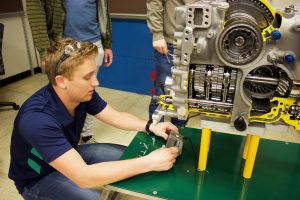
When it comes to a really hits-the-nail-on-the-head engineering capstone project, it would be hard to top the one found at IUPUI’s Mechanical Engineering Technology program. The School of Engineering and Technology is located at a campus shared by Indiana University and Purdue University in Indianapolis (IUPUI). Program lecturer Ed Herger brings a strong background in the field to his classroom. After several years in industry, working in the research and development area of materials science to the manufacture of products ranging from thermal instruments to exercise equipment, he began a career in education as adjunct professor in a community college. It happened to be a Haas-affiliated school in California that stressed hands-on learning with Haas CNC (Computer Numerical Control) machine tools and CAD/CAM (Computer-Aided Design/Computer-Aided Manufacturing) operations with Mastercam® software.
“This gave me the experience I needed to teach here,” said Herger. “The students who elect to study mechanical engineering technology, as opposed to mechanical engineering, are exposed to more of what happens on the manufacturing floor, beyond design disciplines. They’re getting a lot of practical skills that they can apply right away after college, whether it’s Mastercam or SOLIDWORKS® or some of the other software programs we teach here.”

Students in the program spend the first two years covering a range of academic subjects before getting heavily into the technology itself beginning in their junior year. Until recently, the program used little online material and concentrated on a traditional curriculum of classroom lectures and practical projects. When it came to CAM software, they taught Mastercam for SOLIDWORKS as an add-in to the program.
“The direction we wanted to go in,” said Herger, “was to provide more CAM experience as well as online and external certificate opportunities. This meant concentrating on Mastercam and the online benefits of Mastercam University, which would give our students the option of receiving a proficiency certificate in addition to a Bachelor of Science degree, with online lessons both in our lab and on the students’ own laptops and home computers. I’ll take two or three units from Mastercam University and have them go through those units on their own and then give them an assignment based on the CAM operations or features shown in those materials. In the class, I’ll put the Mastercam lesson, as well as my own assignments, on the computer and project it onto a large screen when it comes to sharing various operations with different work groups. I believe they’ve been pretty successful completing the Mastercam University assignments and my own assignments. In my class, students simply follow the online course from start to finish. I just monitor them as they go through the lessons and I’ve been pleased with the way their certificate work has progressed.”

Before students get to Ed Herger’s Mastercam classes, they first complete several courses in 3D types of modeling, as well as quite a bit of print reading and hands-on manufacturing processes. This is followed by a focus on parametric modeling using SOLIDWORKS. Once in Mr. Herger’s class, they begin receiving a strong diet of Mastercam. “I typically give them a big project to work on,” said Herger, “such as mold work or dies for certain parts. My overall approach is to give them a more all-encompassing type of project as opposed to several small, specific exercises that have little in the way of practical application. For example, I recently had them reverse-engineer a micrometer, a precision measuring device. They designed several programs for tooling to make parts for the micrometer. They then figured out how to use some advanced features of Mastercam to program the machine operations in our computer lab. I guess what I’m saying is that I try to give them a project with real-world application and I try not to give them too many hard guidelines on how to do it. They also learn more effectively when they try to figure things out for themselves before I jump in.”

Mr. Herger said that he uses quite a few features of Mastercam to get the most out of their CNC machines’ capabilities, pointing to the benefits of Dynamic Milling. “We’ve made a lot of big, complicated parts out of aluminum blocks,” he said. “A lot of what we focus on is 3D surface milling in order to make complex shapes for molds and dies. A good example of this is the U-shaped frame of the micrometer. It’s about a six-hour program and the die came out great. Of course, we do all the contouring and circle-type toolpaths required to complete the part using Mastercam from start to finish. I can’t really think of any 3-axis CAM feature we haven’t at least touched on. The micrometer measured in the 0-1” range and overall length of the device was about three inches or so. We made a set of dies in tool steel to make the U-shaped frame and we made a small stamp, also in tool steel, in order to mark the sleeve of the micrometer with all the different numbers and markings.”

Also included in the micrometer project was a small mold for the rotating thimble. It contained tiny ascending numbers and position marks inside the mold. “They had to put a number of different fillets inside the CAD program and then make sure they could actually machine those tiny markings into the die,” said Herger. “The students took a few iterations to figure out which of the 3D milling surface approaches would be effective and certainly a few of them failed to generate toolpaths. They finally figured out that a parallel type surfacing toolpath was a little less sensitive to the weird geometries that they were doing, and it ultimately came out really nice.” The class also produced a marking die for all the .05” marks on the micrometer sleeve, run as an inverse engraving program. “They machined out all the outside areas,” he said, “and left the raised marks using a 1/8”, 60-degree engraving tool. I try to impress on them that they should use every bit of this great technology that’s available to them, to their advantage.”
Ed Herger is especially enthusiastic when it comes to the big capstone project for his students. “Because we’re in Indianapolis,” he said, “it’s only natural that we’re in touch with the automotive racing scene and even have our own motor sports program. The Indianapolis Motor Speedway has a demonstration transmission from an Indy car on display at their museum and it’s cut away in a number of places so you can see what’s going on inside. Up until last fall it was a static display. We were fortunate to get the project from the museum where we would animate and automate the transmission so that it would be an interactive display that would rotate at a slow speed and visitors would be able to shift it with a model of the steering wheel from the same car. All of the brackets that connected the small electric motor to turn the transmission, as well as many smaller components and a linear actuator to actually shift the linkage, were machined using Mastercam.”

for the transmission capstone project.
Using the Dynamic Milling feature of Mastercam, students are able to push the machines pretty fast. “For example, when it came to the brackets,” Mr. Herger said, “we started off with a 2” x 2” x 2” block of aluminum for a component that wound up as a 5/8” thick plate with a couple of cylindrical bosses on the back that extended out somewhere between ½” and ¾,” depending on location. These bosses allowed the plate to be bolted up to the transmission while still giving it some standoff clearance. Using the Dynamic Milling program, we used a ½” end mill and full depth of cut to get rid of most of the material.
“Essentially, we were removing all the material down to about an inch-and-a-quarter with the exception of the three cylindrical bosses. We used a ½” ball end mill to leave a fillet at the bottom of the bosses. We let Mastercam come up with the toolpaths and Dynamic Milling optimized cutting operations. The Verify (simulation) feature of Mastercam is something we use for every single program right before we run it. We go back through all the different steps of each program that need to be checked out to make sure there’s no potential issue sitting there. I’d have to say, this capstone project, as well as many other projects, have been fantastic for our students and our program.”

Shaun Rifield is one of Ed Herger’s students. “Using Mastercam at school has been a revelation,” he said. “I’ve had the opportunity to work around CNC machines for a few years now, but never had an opportunity to really learn a CAM software. The videos were easy enough to follow and the homework assignments were good practice. The micrometer project was interesting. I enjoyed having the chance to design a new way to ‘zero,’ manufacture, and assemble the tool. Working cross-functionally with other teams reminded me of working at Navistar. This project felt very real world.”
Rounding out IUPUI’s Mechanical Engineering Technology program with such a strong hands-on capstone project is certainly within Ed Herger’s aim to give his students a strong set of skills looked for by today’s hiring manufacturing firms.
About Mastercam & CNC Software
As an industry leader for more than 35 years, CNC Software takes pride in meeting the demanding needs of our customers by providing excellent products at affordable prices. We adhere to our strategy of combining superior software programming with practical shop floor experience. We have remained at the forefront of CAD/CAM technology by listening to our customers’ needs, being accessible, and most of all, being dedicated to our customers. CNC Software has provided CAD/CAM solutions to more than 250,000 installations worldwide in the moldmaking, automotive, aerospace, and consumer industries.










































